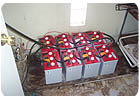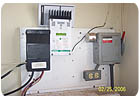Cool Roofing: A Bright Future

In the past few decades, solar cell technology has evolved from powering calculators to powering emergency road signs, parking lot lights and satellites to providing all of the electrical power for houses.
This is all possible due to the power of the sun, which on a bright sunny day can provide up to 1,000 watts of energy per square meter of the Earth's surface. NASA's Mars Rovers are currently being powered by the sun. The two rovers have functioned for nearly a year on solar power alone; this is far more time than the originally anticipated 90-day period. Advancements in technology, primarily through research conducted by NASA, have made harnessing the power of the sun and using it to generate power a relatively simple task.

Photovoltaic Cells
Through the use of photovoltaic cells on the solar panels, sunlight is directly converted into electricity. When sunlight strikes the cells of the solar panels, a certain portion of the light is absorbed into the semiconductor as energy. The absorbed energy loosens electrons, allowing them to flow freely. Photovoltaic cells also have one or more electric fields that flow in a certain direction when the electrons are fused by light absorption. The flow of electrons forms a current that provides external energy when it is coupled with the cells' voltage.Photovoltaic cells are either round or square and can be produced from a number of different types of cells. The most common types of cells are silicon. These types of cells produce two to four amps of current. Silicon is divided into two parts - an N-type and a P-type - which direct where the current flows. Solar cells are soldered together and fabricated into panels. Typically, 36 cells are connected to provide the proper level of voltage and current.
The cell is finished by applying a contact grid over the N-type and P-type cells. Silicon is by nature a shiny material, and it is very reflective. An anti-reflective coating has to be applied over the top of the cell to reduce losses from reflection to less than 5 percent. A glass cover plate is applied over the completed cell structure to protect the cells from the elements.
Batteries
Energy produced from the cells is stored into a storage point - a battery. The batteries store energy produced during the day from sunshine and distribute the power as needed at night. The most common types of batteries used for this process are 12-volt deep-cycle batteries that can store energy while still maintaining a long service life. These can be lead-acid or nickel-cadmium batteries. The nickel-cadmium batteries are more expensive; however, they last longer and can be discharged without harm. Starting batteries are also used in these applications and are designed for high working power, but not deep cycling. These batteries do not work for long periods of time in deep-cycle applications. Deep cell batteries are best for use with inverters.Batteries play an essential role in the success of the system, and it is imperative that the selected batteries provide for all of the electrical requirements. The necessary battery requirements can be computed using the amperage requirements of the appliances to be powered. Most manufacturers provide this information on the appliances.
The required formula is:
Watts = Volts x Amps
Divide the wattage of the load by the battery voltage to determine the amperage the load will draw from the batteries. If the AC current is known, then the battery amperage will be:
AC Current x AC Voltage = DC Amps
Battery Voltage
Multiply the amperage by the number of hours the load will operate to compute the required amp hours. All required electrical appliances and lighting should be included in these calculations.

Inverters
Electricity generated by the PV modules is stored in the batteries as direct current (DC), while electricity that is provided by utility companies and prominent in the use of all appliances in the United States is alternating current (AC). To change the currents from DC to AC, an inverter is required. Some PV modules have an inverter built into each module. PV modules also require mounting hardware, wiring, junction boxes, grounding equipment and other accessories.Inverters have LED lights that indicate that the system is performing at full level. A green light signifies that the system is providing full output voltage. The light turns yellow or blinks when charging is required.
Inverters omit output waveforms that are suitable to run a wide variety of operations. Waveforms from inverters differ from those of utility-generated electricity, which typically takes the form of flat lines. Waveforms from inverters can be square waves, sine waves or modified sine waves. The operations that can be run include induction motors, such as refrigerators and drill presses; restrictive loads, such as heaters and toasters; universal motors, such as hand tools and vacuum cleaners, as well as microwaves, televisions, computers and lighting.

Locating Solar Panels
The maximum amount of power is generated through continual exposure to the sunlight. This is accomplished in the United States and the Northern Hemisphere by facing the panels directly south. In the Southern Hemisphere, the panels should face north. The east and west directions of the panels depend on the local climate. If mornings in the area are routinely foggy, then the panels should be positioned to the west. If there are large trees or other obstructions blocking the sun to the east, then the panels should be positioned facing west.It is also important to determine the proper tilt angle of the panels. The tilt angle may change throughout the year as the earth moves around the sun. However, most users mount the panels in a permanent position based on an angle close to the winter position, which is perpendicular to the sun at noon. During the summer hours, the loss of surface exposure is compensated by longer hours of sun exposure. If the roof slopes in the proper direction, the panels can be mounted directly to it.
To determine the best tilt angle of the panels, the chart in Figure 1 can be used. It is necessary to determine the approximate latitude of the geographic area through the use of an almanac.
Tilt angles are measured by the angle between the flat surface of the panels and the horizon. The smaller the tilt angle, the flatter the panel. The larger the tilt angle, the more the panel will stay upright.

The Size of the System
In order to properly size solar panels, the total electric needs must be determined. Listing all of the required appliances and estimating the daily usage can help determine these requirements. Multiply the number of hours of amperage used by each appliance - including lighting - by the average number of hours each appliance will run. This calculation provides the total number of amp hours. Finally, divide the total amp hours by the number of available hours of sunlight per day to determine the proper panel size. The best practice is to allow a minimum of 20 percent energy loss for the battery storage efficiency. Add an additional 15 percent loss for the use of the inverter. Once the proper amp size is determined, choose panels large enough to provide the amp requirements.Solar technology has made great strides in the past decade, and advancements will continue at a greater pace as more companies continue research and development and more communities use it as a power source for home electricity. Solar power in its present form can be economical, clean and environmentally safe. In the next decade, the projected advancements in technology will make solar power a viable alternative as a primary source of electrical power.
Looking for a reprint of this article?
From high-res PDFs to custom plaques, order your copy today!


